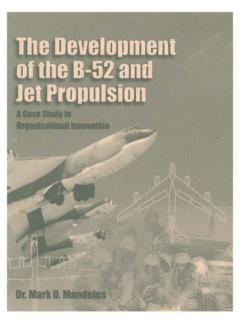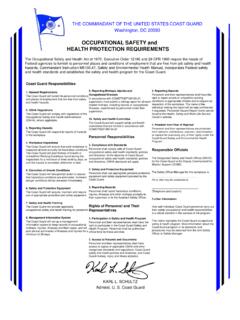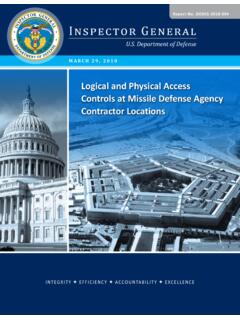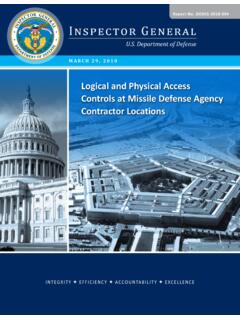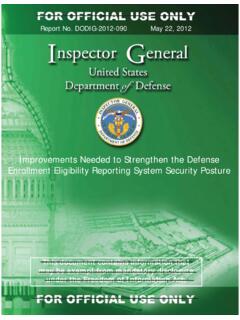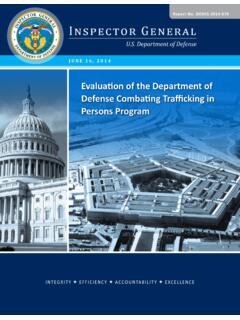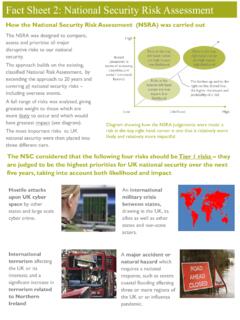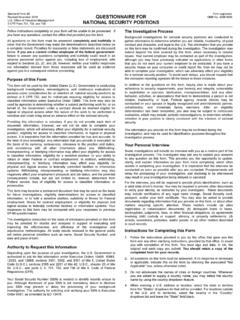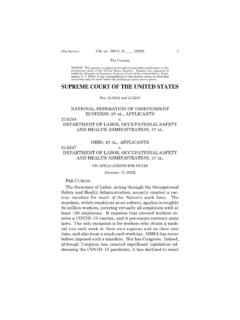Transcription of Embracing a Zero Trust Security Model
1 Contact Cybersecurity Inquiries: 410-854-4200, Media Inquiries: 443-634-0721, U/OO/115131-21 | PP-21-0191 | February 2021 Ver. National Security Agency | Cybersecurity Information Embracing a zero Trust Security Model Executive Summary As cybersecurity professionals defend increasingly dispersed and complex enterprise networks from sophisticated cyber threats, Embracing a zero Trust Security Model and the mindset necessary to deploy and operate a system engineered according to zero Trust principles can better position them to secure sensitive data, systems, and services. zero Trust is a Security Model , a set of system design principles, and a coordinated cybersecurity and system management strategy based on an acknowledgement that threats exist both inside and outside traditional network boundaries. The zero Trust Security Model eliminates implicit Trust in any one element, node, or service and instead requires continuous verification of the operational picture via real-time information fed from multiple sources to determine access and other system responses.
2 The zero Trust Security Model assumes that a breach is inevitable or has likely already occurred, so it constantly limits access to only what is needed and looks for anomalous or malicious activity. zero Trust embeds comprehensive Security monitoring; granular risk-based access controls; and system Security automation in a coordinated manner throughout all aspects of the infrastructure in order to focus on protecting critical assets (data) in real-time within a dynamic threat environment. This data-centric Security Model allows the concept of least-privileged access to be applied for every access decision , allowing or denying access to resources based on the combination of several contextual factors. Systems that are designed using zero Trust principals should be better positioned to address existing threats, but transitioning to such a system requires careful planning to avoid weakening the Security posture along the way. NSA continues to monitor the technologies that can contribute to a zero Trust solution and will provide additional guidance as warranted.
3 To be fully effective to minimize risk and enable robust and timely responses, zero Trust principles and concepts must permeate most aspects of the network and its operations ecosystem. Organizations, from chief executive to engineer and operator, must understand and commit to the zero Trust mindset before embarking on a zero Trust path. The following cybersecurity guidance explains the zero Trust Security Model and its benefits, as well as challenges for implementation. It discusses the importance of building a detailed strategy, dedicating the necessary resources, maturing the implementation, and fully committing to the zero Trust Model to achieve the desired results. The following recommendations will assist cybersecurity leaders, enterprise network owners, and administrators who are considering Embracing this modern cybersecurity Model . U/OO/115131-21 | PP-21-0191 | February 2021 Ver. 2 NSA | Embracing a zero Trust Security Model Falling behind Today s IT landscape is empowered by a connected world that is more susceptible to malicious activity due to its connectedness, user diversity, wealth of devices, and globally distributed applications and services.
4 Systems and users require simple and secure methods of connecting and interacting with organizational resources, while also keeping malicious actors at bay. The increasing complexity of current and emerging cloud, multi-cloud, and hybrid network environments combined with the rapidly escalating and evolving nature of adversary threats has exposed the lack of effectiveness of traditional network cybersecurity defenses. Traditional perimeter-based network defenses with multiple layers of disjointed Security technologies have proven themselves to be unable to meet the cybersecurity needs due to the current threat environment. Contemporary threat actors, from cyber criminals to nation-state actors, have become more persistent, more stealthy, and more subtle; thus, they demonstrate an ability to penetrate network perimeter defenses with regularity. These threat actors, as well as insider threat actors, have succeeded in leveraging their access to endanger and inflict harm on national and economic Security .
5 Even the most skilled cybersecurity professionals are challenged when defending dispersed enterprise networks from ever more sophisticated cyber threats. Organizations need a better way to secure their infrastructure and provide unified-yet-granular access control to data, services, applications, and infrastructure. By implementing a modern cybersecurity strategy that integrates visibility from multiple vantage points, makes risk-aware access decisions, and automates detection and response actions, network defenders will be in a much better position to secure sensitive data, systems, applications, and services. zero Trust is an assumed breach Security Model that is meant to guide cybersecurity architects, integrators, and implementers in integrating disparate but related cybersecurity capabilities into a cohesive engine for cybersecurity decision -making. However, to be fully effective, zero Trust principles need to permeate most aspects of the network and its operations ecosystem to minimize risk and enable robust and timely responses.
6 Organizations that choose to migrate to a zero Trust solution should fully embrace this Security Model and the mindset necessary for planning, resourcing, and operating under this Security Model to achieve the cybersecurity outcomes that a zero Trust solution can deliver [1] [2]. Increasingly sophisticated threats Embracing a zero Trust Security Model , and re-engineering an existing information system based on this Security Model , is a strategic effort that will take time to achieve full benefits. It is not a tactical mitigation response to new adversary tools, tactics, and techniques. However, several recent, highly publicized system breaches have exposed widespread vulnerabilities in systems, as well as deficiencies in system management and defensive network operations. These incidents show that purely tactical responses are often insufficient. A mature zero Trust environment will afford cybersecurity defenders more opportunities to detect novel threat actors, and more response options that can be quickly deployed to address sophisticated threats.
7 Adopting the mindset required to successfully operate a zero Trust environment will further sensitize cybersecurity defenders to recognize ever more subtle threat indicators. Tactical responses will likely still be necessary even in a zero Trust environment, but with the appropriate Security Model , mindset, and response tools, defenders can begin to react effectively to increasingly sophisticated threats. What is zero Trust ? zero Trust is a Security Model , a set of system design principles, and a coordinated cybersecurity and system management strategy based on an acknowledgement that threats exist both inside and outside traditional network boundaries. zero Trust repeatedly questions the premise that users, devices, and network components should be implicitly trusted based on their location within the network. zero Trust embeds comprehensive Security monitoring; granular, dynamic, and risk-based access controls; and system Security automation in a coordinated manner throughout all aspects of the infrastructure in order to focus specifically on protecting critical assets (data) in real-time within a dynamic threat environment.
8 This data-centric Security Model allows the concept of least privileged access to be applied for every access decision , where the answers to the questions of who, what, when, where, and how are critical for appropriately allowing or denying access to resources [3]. NSA strongly recommends that a zero Trust Security Model be considered for critical networks to include National Security Systems (NSS), Department of Defense (DoD) networks, and Defense Industrial Base (DIB) systems. Integrating U/OO/115131-21 | PP-21-0191 | February 2021 Ver. 3 NSA | Embracing a zero Trust Security Model these principles within certain environments, especially within a large enterprise, can become complicated. To address these challenges, NSA is developing additional guidance to organize, guide, and simplify the zero Trust design approach. Adopt a zero Trust mindset To adequately address the modern dynamic threat environment requires: Coordinated and aggressive system monitoring, system management, and defensive operations capabilities.
9 Assuming all requests for critical resources and all network traffic may be malicious. Assuming all devices and infrastructure may be compromised. Accepting that all access approvals to critical resources incur risk, and being prepared to perform rapid damage assessment, control, and recovery operations. Embrace zero Trust guiding principles A zero Trust solution requires operational capabilities that: Never Trust , always verify Treat every user, device, application/workload, and data flow as untrusted. Authenticate and explicitly authorize each to the least privilege required using dynamic Security policies. Assume breach Consciously operate and defend resources with the assumption that an adversary already has presence within the environment. Deny by default and heavily scrutinize all users, devices, data flows, and requests for access. Log, inspect, and continuously monitor all configuration changes, resource accesses, and network traffic for suspicious activity.
10 Verify explicitly Access to all resources should be conducted in a consistent and secure manner using multiple attributes (dynamic and static) to derive confidence levels for contextual access decisions to resources. Leverage zero Trust design concepts When designing a zero Trust solution: Define mission outcomes Derive the zero Trust architecture from organization-specific mission requirements that identify the critical Data/Assets/Applications/Services (DAAS). Architect from the inside out First, focus on protecting critical DAAS. Second, secure all paths to access them. Determine who/what needs access to the DAAS to create access control policies Create Security policies and apply them consistently across all environments (LAN, WAN, endpoint, perimeter, mobile, etc.). Inspect and log all traffic before acting Establish full visibility of all activity across all layers from endpoints and the network to enable analytics that can detect suspicious activity.

